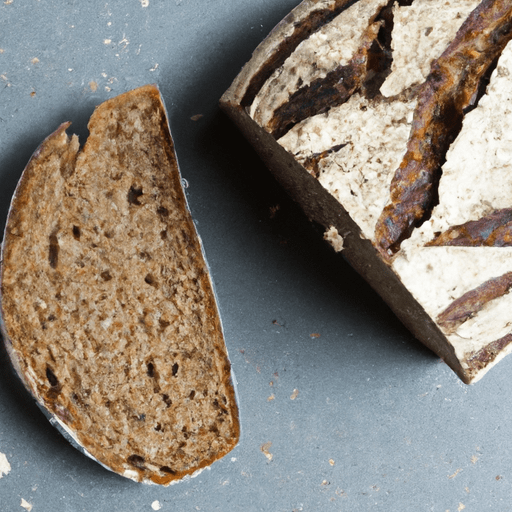Rye Bread: A Nutritious and Flavorful Delight
When it comes to bread, there is a wide variety to choose from. However, one type that stands out for its distinct flavor and health benefits is rye bread. Originating in Northern and Eastern Europe, rye bread has a rich history and an intriguing flavor profile that has made it a beloved staple in many cuisines.
A Taste Sensation
Rye bread possesses a robust, slightly tangy flavor that sets it apart from other bread varieties. The combination of its earthy taste and dense texture makes it a perfect choice for those seeking a hearty and satisfying bread experience. Whether toasted and spread with butter or topped with your favorite sandwich fixings, rye bread adds a delightful complexity to any meal.
Versatile in the Kitchen
Rye bread’s versatility extends beyond being a simple sandwich carrier. Its distinct flavor can elevate the taste of various dishes. Croutons made from rye bread add a crunchy texture and a hint of tanginess to salads, while rye bread crumbs provide a unique twist to meatballs or breaded fish. Rye bread can also be used to create mouthwatering stuffing for poultry or transformed into delectable French toast. The possibilities are endless!
Nutritional Benefits
While the tantalizing taste of rye bread is reason enough to love it, its nutritional value makes it even more appealing. Rye bread is a rich source of dietary fiber, providing a substantial amount of the recommended daily intake. This fiber not only aids in digestion but also helps regulate blood sugar levels and keeps you feeling fuller for longer. Rye bread also contains valuable nutrients such as B vitamins, iron, and magnesium, making it a healthy choice for those looking to nourish their bodies.
A Journey through Time
Rye bread has an intriguing history that spans centuries. Dating back to medieval times, rye was more common in colder climates where wheat had difficulties growing. As a result, rye became a staple grain in Northern and Eastern European countries such as Germany, Russia, and Finland. Rye bread was often associated with hearty peasant-style cooking and later gained popularity among urban populations. Today, it remains an essential part of the culinary heritage of many cultures, celebrated for its unique taste and versatility.
Fun Facts
- In Scandinavian countries, a traditional dark rye bread known as “rugbrød” is often enjoyed with toppings such as cheese, butter, or pickled herring.
- Rye bread is sometimes used to make “smørrebrød,” an open-faced sandwich popular in Danish cuisine, topped with various ingredients such as fish, meats, and vegetables.
- Rye bread can be baked in various forms, from traditional loaves to round loaves with a hollowed-out center known as “ryebread bowls,” perfect for serving soups or dips.
Conclusion
Rye bread is a truly remarkable culinary creation, combining a distinct flavor, versatility, and nutritional benefits. Whether you crave a hearty sandwich, a delightful crouton, or a slice of toast in the morning, rye bread is sure to satisfy your taste buds. Celebrate the rich history and enjoy the fulfilling experience of rye bread – a remarkable addition to any food lover’s kitchen.
Rye Bread
Origin: Rye bread has been consumed for centuries and is believed to have originated in Eastern Europe, particularly in what is now modern-day Russia and Baltic states. It was then brought to Northern Europe where it gained popularity.
Common Uses: Rye bread is commonly used as a staple food in many Northern and Eastern European countries, such as Germany, Scandinavia, and Russia. It is often enjoyed as a sandwich bread, served with various toppings, or used for making traditional dishes like open-faced sandwiches (smørrebrød) in Denmark and Swedish rye crispbread.
Nutritional Benefits: Rye bread offers several nutritional benefits. It is an excellent source of dietary fiber, which helps support digestive health and keeps you feeling full for longer. Rye bread also contains essential minerals such as iron, magnesium, and potassium. Additionally, it tends to have a lower glycemic index compared to some other types of bread, which means it releases glucose into the blood more slowly.
Unique Properties: Rye bread has a dense and hearty texture with a distinct, slightly tangy flavor. This is due to its high fiber content and the presence of lactic acid bacteria, which give it a sourdough-like taste. Due to its dense composition, rye bread has longer shelf life compared to bread made solely from wheat flour.
Historical Significance: Rye bread has played a significant role in history. During periods of scarcity or famine, it often provided a crucial food source because rye is more cold-hardy and grows well in harsher climates compared to other grains like wheat. In Eastern Europe, rye bread became a symbol of resilience and cultural identity, reflecting the resourcefulness and strength of the people who relied on it for sustenance.




Use the share button below if you liked it.
It makes me smile, when I see it.